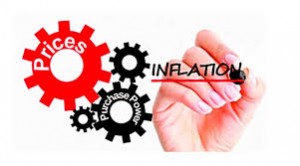True Fact: In 2008, the cost of a loaf of bread in Zimbabwe was around $550 million.
Shocked? Well, don’t be because the reason behind this is not something unimaginable but something as common yet powerful as inflation.
Inflation can be defined as the sustained increase in the overall price level of goods and services. With an increase in inflation, each dollar buys a smaller percentage of a good. Zimbabwe, was faced with a special case of very high inflation, known as hyperinflation and the inflation rate touched 79.6 billion percent in 2008. Recently, it was announces that the Fed in the US is aiming for an inflation rate of 2 percent, while in India the RBI has been trying to achieve an inflation rate of approximately 4 percent. In order to decide which of the above inflation rates is suitable for a country, one must delve deeper into the costs and benefits of inflation but before deliberating upon those, it is important to look at the causes of inflation. Inflation can be a result of many of the policies undertaken by the government including quantitative easing wherein the government increases the money supply in order to finance its deficits, supply shocks due to wars or calamities, depreciation of the currency due to other economic factors or it could be demand side inflation due to factors including consumption, investment, public spending or net exports that affect aggregate demand(C+I+G+NX).
The consequences of inflation can be quite severe and its disadvantages are as follows:
- Shoe-leather costs: opportunity costs of time and money due to increased visits to the bank
- Menu costs: costs of changing prices list
- Decrease in investment and fall in savings
- Reduced international competitiveness and fall in exports
- Income redistribution making borrowers better off and lenders worse off
While inflation has its shortcomings, it also has some benefits including easier adjustment of real wages and prices and higher growth. According to Philips, there is an inverse relationship between inflation and unemployment in the long run. There is a tradeoff between the two and as inflation increases, unemployment decreases. The curve tracing this path is known as the Philip’s curve.
Thus, most countries do not want a very low rate of inflation as that would mean high unemployment in the long run but they also do not want high levels of inflation due to the costs involved with it. Thus a moderate inflation rate is what most countries would want to achieve.
Click here for government certification in Accounting, Banking & Finance





23 Comments. Leave new
Most important topic to be discussed in today’s life. Nicely written.
Thank you Megha and I completely agree with you!
Very well explained.
Some level of inflation is necessary in an economy.. Good work!
Interesting.
Very well written!
well written.
Some level is required for the economy to grow!
Nice work!
I always feel it works well if inflation remains in moderation. Well written. 🙂
very well written
Very nice topic for discussion!
good work
Informative
Very well explained
nicely Written 😀
Informative !
Well articulated!
nice 🙂
Descriptive and informative.
good effort!
Thanks everyone 🙂
Inflation has serious ramifications derailing the economy, prices sky rocket, hampers the industrial growth thud decreasing the real purchasing power very well written great efforts
Thank you!